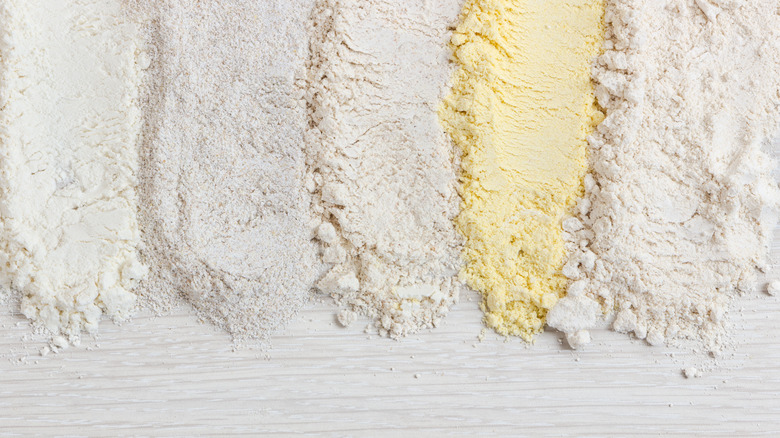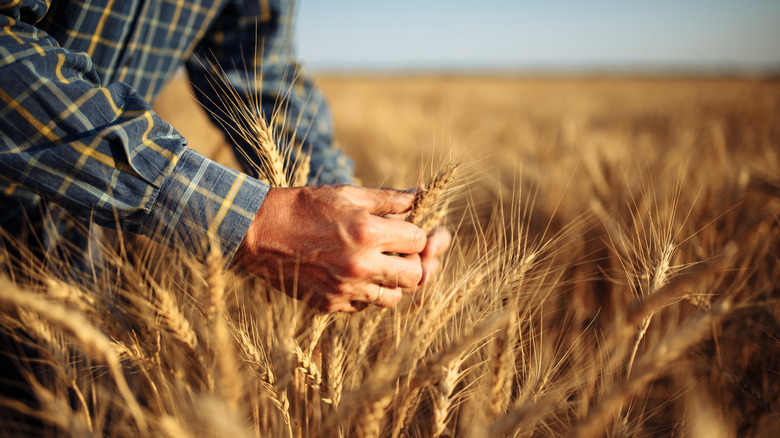Why Flour Grown In The Southern Vs Northern US Tastes Different
Baking is a science, meaning that even minuscule changes to ingredients and baking times can have drastic results in a final product. Even the types of ingredients used for a recipe can alter an entire bake. Nowhere is this more true than with flour, to the point where chefs like Giada De Laurentiis even have favorite flour brands for baking. There is such a wide range of flour to use that there are even taste differences between flour grown in the Southern United States and flour grown in the Northern United States.
The reason for this discrepancy has to do with two different types of wheat: soft and hard. When ground, soft wheat feels more like a powder, while hard wheat will have larger grains and a more coarse texture. However, the real difference between the two categories is at the molecular level. Soft wheat flour has a protein content of about 8-12%, whereas hard wheat ranges between 12-15%. The amount of protein in wheat determines how well it can create gluten, which in turn affects a baked good's consistency and taste.
Southern wheat that is harvested and turned into flour is typically soft wheat, while its Northern counterpart is more likely to be hard wheat. Anyone who has had a traditional Southern biscuit can attest to its tender texture, which is due in part to the use of soft wheat flour. But these aren't the only wheat classifications that affect flour.
Wheat color and season also determine a flour's taste
In the United States, wheat typically comes in two colors: red and white, in reference to the color of the wheat's outer layer, known as the bran. Any bag of flour that says it is "whole wheat" will contain the bran while more refined flours don't include it. The result is an almost imperceptible color difference between the two types of flour, along with another taste difference. Red wheat flour has a bitterness that white wheat flour does not and it has a slightly higher protein content.
Wheat is also often classified by season. Spring wheat is usually planted in April and is ready for harvest by August. In many regions, winter wheat is planted in September, starts to grow, and then pauses during the winter months. The following spring, it begins growing again and is generally ready for harvest by May. This harvest time also affects protein content. Spring wheat comes in at 12-14% protein, while winter wheat is 10-12%. In terms of Northern and Southern flour, both are usually winter wheats.
With all of these elements juxtaposed against each other, it may feel like there is a labyrinth of flour types to navigate. There are, however, a few simple rules that will help you make the right choice for your next bake.
Different flours are best for different baking projects
The determining factor for selecting flour is almost always going to be its protein content. More protein equals more gluten, which is great for bread but not so hot for tender cakes or cookies.
Hard red spring wheat is the protein king. This makes flour that is great for hard breads, bagels, and pizza dough recipes worthy of the next National Pizza Day. Hard red winter wheat is slightly less protein-rich, meaning it works well as an all-purpose flour for bread and pasta. Soft red winter wheat finds its way into many crackers and cookies, while soft white winter wheat is great for delicate cakes and quick breads like muffins and Southern biscuits.
While these are the basic flour tenets, there is still a lot of variation when it comes to commercially available flour. Many brands will combine different wheats to achieve the desired protein levels. So, with any flour choice, it is essential to check the protein content on the bag's label. It can mean the difference between the normal science of baking and creating a monster in the kitchen.



